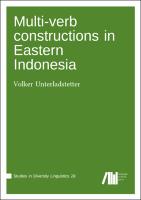Multi-verb constructions in Eastern Indonesia (Volume 28)
Author(s)
Unterladstetter, Volker
Collection
Knowledge Unlatched (KU)Number
106008Language
EnglishAbstract
Constructions with multiple verbal elements have posed a long-standing challenge to linguistic analysis. Most studies of verb serialisation have been confined to single languages rather than looking at crosslinguistic patterns. This book provides the first in-depth account into the areal characteristics of multi-verb constructions (MVCs) in Eastern Indonesia. By collating published data as well as corpus data from 32 Austronesian and Papuan languages, the study traces commonalities as well as differences in MVC use across the area. Analysis takes place on two levels: first, the morpho-syntactic behaviour of MVCs is taken into account. As this plane of analysis arguably does not provide any meaningful insights into why MVCs are construed and used the way they are, a semantic account of MVCs is presented. One of the main hypotheses advanced in this book is that the crucial driving force behind multi-verb construals is semantic interaction between the verbs, leading to four principal techniques of event formation: merging, staging, modification, and free juxtaposition. The study aims at showing that while all four techniques are, to varying degrees, in use in Eastern Indonesian languages, the morpho-syntactic output does not necessarily mirror these underlying differences in event conception. Applying insights from Davidsonian event semantics as well as from predicate decomposition, the book provides a model of event interaction that helps to explain differences in MVC behaviour such as issues in constituent order or operator assignment.
Keywords
Language Arts & Disciplines; Linguistics; SyntaxDOI
https://doi.org/10.5281/zenodo.3546018ISBN
9783961102167Publisher
Language Science PressPublisher website
https://langsci-press.org/Publication date and place
2020Grantor
Imprint
Language Science PressClassification
Grammar, syntax and morphology


 Download
Download